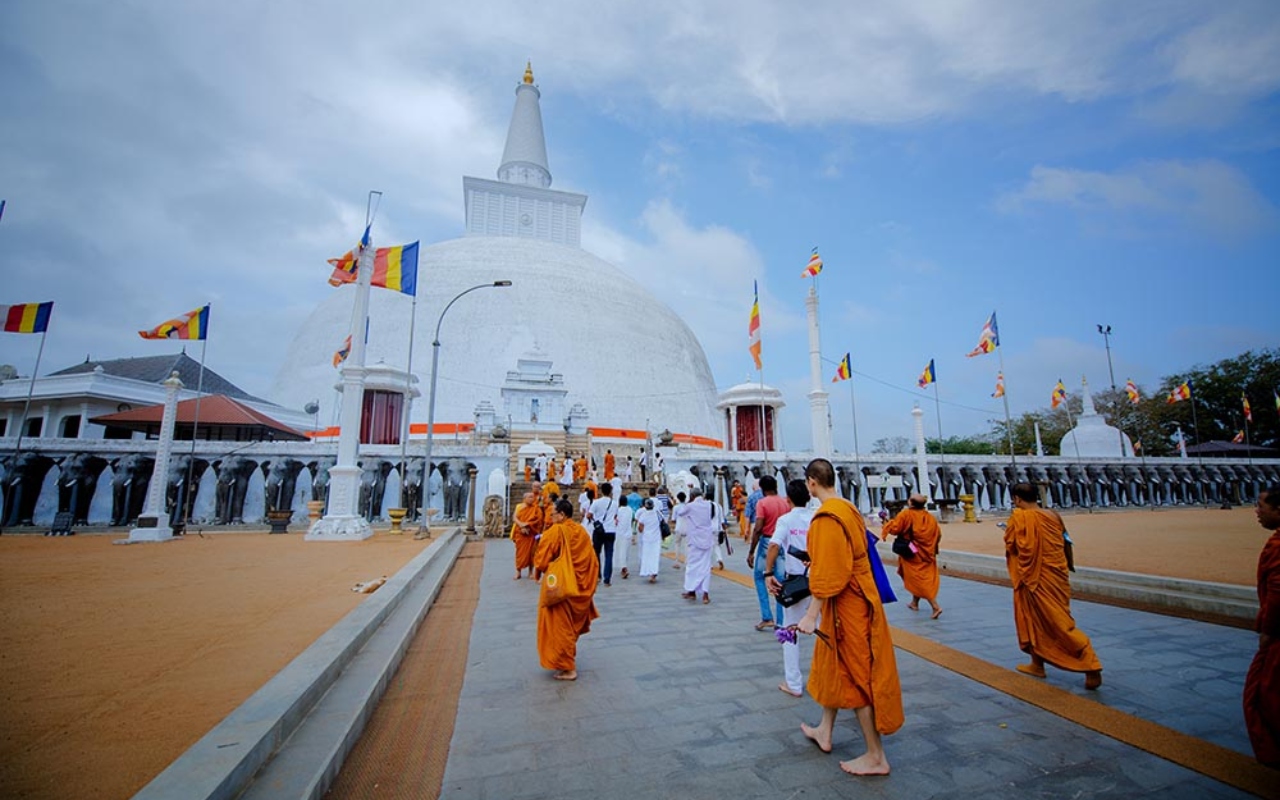Although the teardrop-shaped pearl of the Indian Ocean is tiny, its story is immense. Etched in stone, painted in frescoes and whispered in the forests, the island’s heritage weaves a rich tapestry of history, culture and nature. UNESCO recognises 8 World Heritage Sites in Sri Lanka – 6 of which are cultural and 2 of which are natural. This guide invites you to unravel the legacy and wonder of the island, with each site telling an extraordinary tale of soul and splendour.
The Sacred City of Anuradhapura
It is where the island’s written history begins. Founded as a city in the 4th century BC, Anuradhapura served as the country’s first capital for over a millennium. The city is also the crowning place of Buddhism in Sri Lanka, with remarkable monuments built in reverence to the faith by a succession of kings.
Today, its sprawling ruins still evoke the grandeur of its golden age, with towering stupas like Ruwanwelisaya and Jetavanarama, the mighty reservoirs that once sustained it, and the revered Sri Maha Bodhi tree, a direct descendant of the very tree under which the Buddha attained enlightenment. Wander through the stone-pillared monasteries, royal parks and bathing ponds that evoke the spirit of a proud civilisation devoted to its faith and a culture resplendent.
Ancient City of Polonnaruwa
After Anuradhapura fell to invaders, Polonnaruwa emerged as the next seat of Sinhala kings. Smaller in scale but no less impressive, this 11th-century capital showcases the island’s peak stone sculptures through perfectly preserved moonstones, intricately carved Gal Vihara Buddha statues, Vatadage and monumental royal buildings. Parakrama Samudraya – a gigantic ancient tank still irrigates the region. Due to its Chola influence, Polonnaruwa contains unique Dravidian architecture. The city is a work of imaginative medieval city planning and aesthetics.
Ancient City of Sigiriya
Rising dramatically out of the jungle plains, Sigiriya became the perfect geological formation for a fortress. This 5th-century citadel, often referred to as the “Lion Rock,” was once the refuge of King Kasyapa, who transformed the 660-foot rock into a palace in the sky.
The climb to the summit takes you past beautifully preserved frescoes of celestial maidens, the mirror wall etched with ancient poetry, and massive lion’s paws guarding the entrance to the top. The panoramic view at the summit, overlooking symmetrical water gardens and dense forest, is nothing short of majestic.
Rangiri Dambulla Cave Temple
Just 30 minutes from Sigiriya lies Dambulla, a sacred cave complex that has served as a place of worship for over 2,000 years. Set into a massive granite outcrop, the Golden Temple of Dambulla is composed of five main caves, each featuring intricately painted ceilings and walls, serene Buddha statues and stupas. Serving as dwellings for Buddhist monks since the 3rd century BC and modified over centuries, the cave complex is one of South and Southeast Asia’s most outstanding Buddhist complexes.
Sacred City of Kandy
Nestled in the hills, the last capital of the Sinhala Kingdom is a cultural stronghold and a famous pilgrim site. The Temple of the Tooth houses a sacred tooth of Buddha – a powerful relic that legitimised royal rule. Kandy creates a distinct atmosphere with its peaceful lake, Kandyan architecture, vibrant traditional arts, cooler climate, and spice gardens. Visit the city during the Esala Perahera, a dazzling procession of dancers, elephants and drummers, and you will witness spirituality and spectacle intertwined as never seen before.
Anuradhapura, Polonnaruwa, Sigiriya, Dambulla and Kandy together form the Cultural Triangle of Sri Lanka.
Old Town of Galle and its Fortifications
Galle is a legendary maritime city coveted by the colonials and occupied by them for centuries. Galle Fort is its crowning glory. First built by the Portuguese in the 16th century and later fortified by the Dutch and the British, this coastal fortification reminds the world of an era lost to history books. Galle is a perfect example of a fortified city built by Europeans in South and Southeast Asia. UNESCO calls it “an urban ensemble which illustrates the interaction of European architecture and South Asian traditions from the 16th to the 19th centuries.”
Cobblestone lanes wind past European-style villas, whitewashed churches, lighthouses, museums, mosques and cafes that spill out under frangipani trees. More than just a historical site, Galle Fort is an atmospheric retreat where art galleries, boutique hotels and artisan shops blend with centuries-old ramparts that still look out across the Ocean.
Sinharaja Forest Reserve
It is Sri Lanka’s last viable primary tropical rainforest. Covering an area of 8,864 ha and ranging from an altitude of 300 – 1,170 meters, the area is a highly endemic biosphere. More than 60% of the trees are endemic, and many of them are considered rare. The reserve is also home to over 50% of Sri Lanka’s endemic butterfly species, as well as numerous insects, reptiles and rare amphibians. More than 95% of bird species are endemic.
A trek through Sinharaja is a sensory journey. Chirping cicadas, the scent of damp earth, crisp air, the flutter of butterfly wings, sunlight breaking through dense emerald canopies, towering trees, tangled vines, calls of exotic birds, mossy roots, and bubbling streams immerse you in pristine wilderness.
Central Highlands of Sri Lanka
Encompassing the Horton Plains National Park, Knuckles Conservation Forest and Peak Wilderness Protected Area, the Central Highlands were the most recent addition to Sri Lanka’s UNESCO list. Here, montane cloud forests roll into grassy plains and dramatic escarpments, supporting species found nowhere else.
Rising to 2,500 metres above sea level, the montane rainforests is a super biodiversity hotspot, hosting an extraordinary range of flora and fauna, including endangered species like the western-purple-faced langur, the Horton Plains slender loris and the Sri Lankan leopard.
Hike to World’s End, a sheer cliff with breathtaking views, or wander among cloud-kissed grassy plains and rhododendron groves. Climb to the sacred summit of Adam’s Peak, a watershed of the island’s most notable rivers and a multi-faith pilgrim site. The Knuckles Conservation Forest contains over 34% of Sri Lanka’s endemic trees, shrubs and herbs, found nowhere else in the world. A hike here is a discovery of a wild treasure trove.
Central Highlands are also the heart of the Tea Country, with plantations covering every mountain slope. Walking amongst the verdant tea bushes, watching how tea is processed at the factories and sipping a fresh brew are ritualistic. Let’s not forget the many cascading waterfalls – sights greeting you at every corner or so.
World Heritage through the Blue Lanka Tours’ Lens
Sri Lanka’s UNESCO World Heritage Sites are keys to understanding the island’s rich identity. Each site offers a different lens: the spiritual, the historical, the natural and the cultural. Whether you are gazing at the horizon from the top of Sigiriya, wandering the breezy alleys of Galle Fort, or standing in awe beneath a thousand-year-old Bodhi tree, you will immediately know why they are precious experiences regarded by the world’s authority.
Blue Lanka Tours showcases Sri Lanka’s UNESCO World Heritage Sites with a deep commitment to responsible travel and authentic cultural immersion. By keeping our footprint light, partnering with knowledgeable guides, promoting off-peak visitation and encouraging respectful engagement with sacred and historic places, we ensure each experience is enriching for you and the island.

